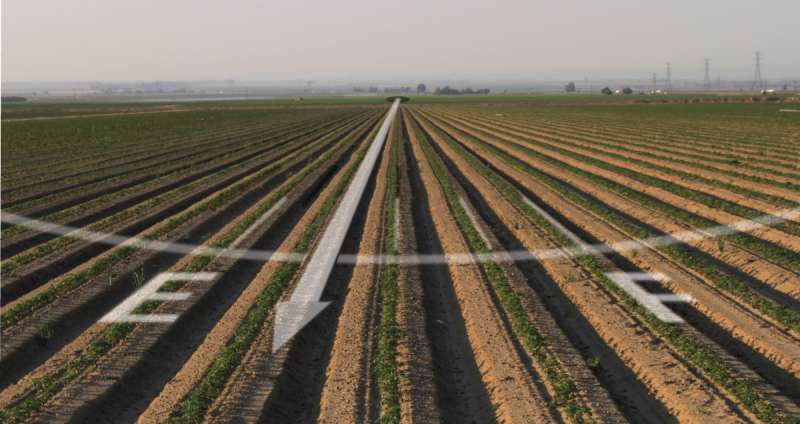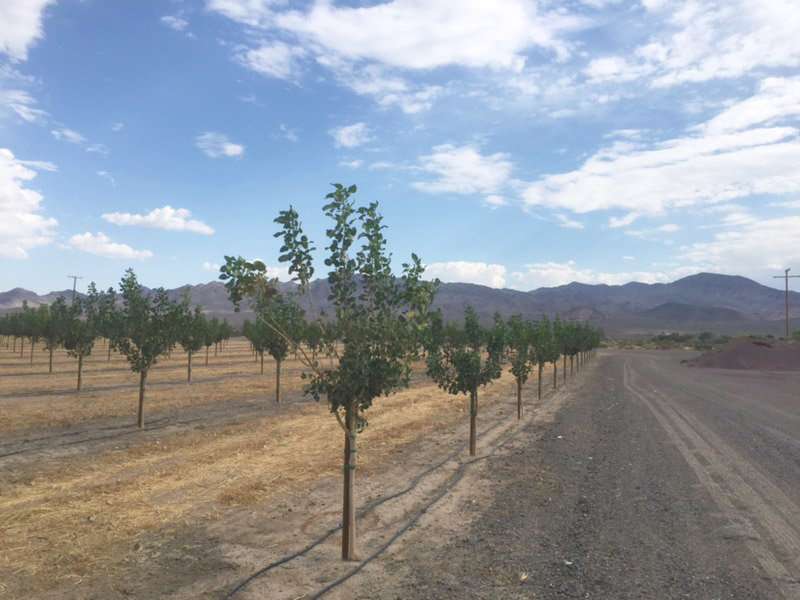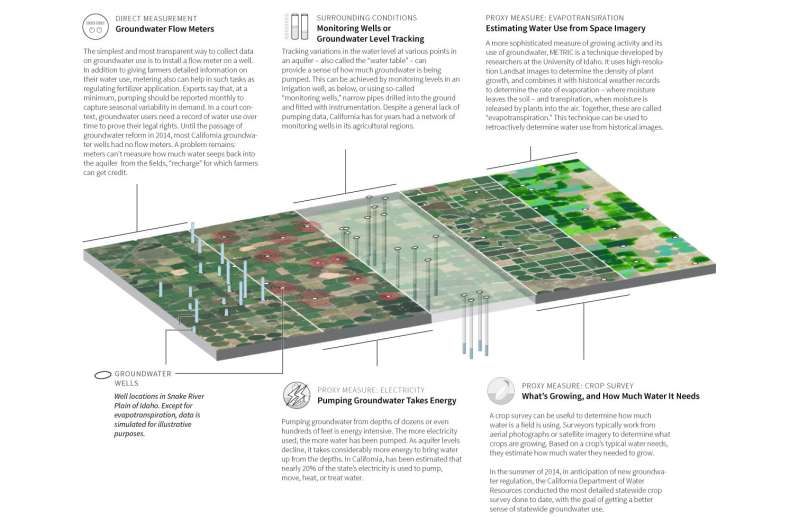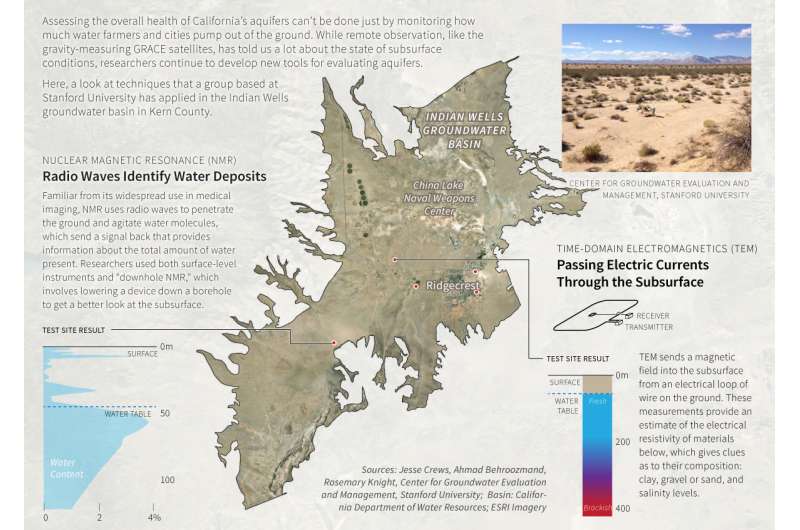Credit: Chris Austin via Flickr
Most areas of California farm country have a significant lack of information about their groundwater use. The water managers responsible for putting California's depleted aquifers on the path to sustainability now need to get the data to do the job. Running the new agencies created under the state's Sustainable Groundwater Management Act, these managers must first decide what they need to know, and how to get the information.
The measuring gauges they need would ideally give two different views of groundwater reality. First, account for withdrawals by identifying who is taking the water, then control the withdrawals to ensure sustainability, now required in 109 of the state's 517 groundwater basins. Second, monitor the overall health of the aquifer to ensure it is not trespassing over the various boundaries of unsustainability now carved into state law.
Before they can explore the technical answers to measuring options, managers must wrestle with local attitudes about privacy that have prevailed in areas subject to chronic over-pumping. Heavy users have for decades ardently resisted any accounting. Well meters were anathema. Newly drilled wells were reported to the state, but by law, that information was kept private.
Such confidentiality restrictions ended in 2015, after the passage of the groundwater act; and in early 2017, the State Water Resources Control board made public its digital map of state wells. But just knowing where the wells are isn't the same as knowing how much they pump, or their impact on the aquifer below.
Pistachio trees growing on the Harter family's farm in Kern County. Credit: Andrew Harter
"As long as nobody was measuring or monitoring groundwater, it was to the advantage of any farmer to pump as much as they could," said Peter Gleick, the co-founder of the Pacific Institute, who has deep expertise on water issues. The system, he said, "was designed to favor ignorance." Other experts reject such a blunt anti-farmer viewpoint. Both agricultural use and urbanization, they say, expanded groundwater use beyond sustainability: fingers could point anywhere.
Even With Pumping Unmetered, Remote Sensing Technology Had Lifted the Veil on Groundwater Depletion
The intransigence of some groundwater users became less of an obstacle with the rise of options for remote observation. For instance, a pair of twin satellites launched by NASA were able to estimate that Central Valley aquifers had, just between 2003 and 2010, lost 25 million acre-feet of groundwater – well more than half of California's annual groundwater use around that time. The GRACE satellites showed the world the depletion many Central Valley farmers were already beginning to tackle.
By the time the GRACE program went out of service last year, even finer-grained analysis was possible using data from additional satellites, like NASA's Landsat orbiters. Such remotely gathered data, along with the need to comply with the new law, has made on-farm metering more palatable. Some managers are learning from areas that have already collected abundant data about groundwater use. Before the new law, the courts spurred the work.
Under State Adjudication for 22 Years, Mojave Agency Keeps a Clear Tally
Credit: Idaho Department of Water Resources; ESRI Earth Imagery; Natural Earth Data, Bill Lane Center for the American West
Ignorance is not something judges accept as an excuse for inaction. Data on wells and groundwater usage is plentiful in groundwater basins that were subject to water rights lawsuits in past years. The Mojave Water Agency works a basin covering 4,900 square miles of desert spreading west from the intersection of California, Nevada and Arizona. The adjudication of its water was handed down in 1996. Every year since, it has duly reported the number of wells drawing groundwater and their annual "production," or withdrawal.
For example, Mojave's report shows that Joe and Sue Harter, proprietors of Harter Farms, in Needles, have 11 agricultural wells and two for domestic use. The Harters took 2,361 acre-feet of water from underneath the desert last year, less than half as much as the 5,234 they pumped in 1990.
Joe Harter's son, Andrew, who grows pistachios and bermuda grass with his father, said that the 1996 court order requiring well accountability "made us progressive about controlling our use," he said. "We had to do more with less." He added, "At the end of the day, we have to have sustainability." What irritates him is the seemingly constant construction of new housing subdivisions, each of which creates new demand for water. "I think sustainability is the best thing. My problem is they put it on the backs of the farmers."
Credit: Bill Lane Center for the American West
At the time of the court order, there was little consistency about measuring and reporting withdrawals of groundwater in the Mojave Water Agency's area. An engineering firm was charged with verifying claims about how much had been pumped. When there were no records, the firm assembled aerial photos of plantings, and used those to estimate how much water different crops used. This prompted most users, like the Harters, to begin collecting their own records, often by using flow meters on their wells.
Electricity consumption is a commonly used proxy for groundwater use, said Mojave's general manager, Tom McCarthy. Water is heavy, and pumping groundwater from depths of dozens or even hundreds of feet is energy intensive. The more electricity used, the more water has been pumped. "We tend to use methods that are tried and true," he said.
The more depleted basins now have new agencies managing them. In less than two years, they must produce plans for long-term sustainability. Some users may find their pumping sharply restricted. Some may trade their water rather than farming with it. All will need good data.
More Accurate Measurement Leads to More Efficient Management
Zbeda said that day-to-day management of the groundwater controlled by the water district is made easier by knowing how much each customer uses. Like McCarthy, he finds that his biggest agricultural users are cooperative, sharing their pumping data. Why? Amidst a groundwater crisis almost two decades ago, a local cooperative formed in the Indian Wells basin and began measuring and sharing their consumption data.
Their two decades of data show that groundwater pumping overall is down 17 percent in the last decade; the biggest agricultural user, Meadowbrook Farms, has cut its annual consumption by nearly a third percent in the same period, from 9,270 acre-feet to 6,387 acre-feet. Mr. Zbeda's water district used 29 percent less over that period. His big agricultural users, mostly pistachio and alfalfa farmers, have been open and cooperative, he said.
Less cooperative, he said, are small users. "Someone saying: 'How much are you pumping?' doesn't play well with a lot of private well owners." He added, "The challenge for us locally is [all users] recognizing there's a need to know who is pumping how much."
Resistance to Individual Measurements Begins to Fade
What Mr. Zbeda faces with some of the smaller agricultural users in his district is what Eric Averett faced 25 years ago. Averett, the general manager of the Rosedale-Rio Bravo Water Storage District, remembers, "there was a hesitancy to share a lot of different types of data. There was more of a private-property mindset, people felt it was confidential, and might affect competitiveness."
But even before the 2014 passage of SGMA, he said, those attitudes began to change, both because of the brutal five-year drought, and the rise of technologies for remote sensing of groundwater levels. He has been to meetings recently when "landowners have called me every name in the book and accused me of being big government."But, he said, general acceptance of accounting for water use has spread widely, even as resistance lingers.
So the transformation in attitudes that began in adjudicated districts in the desert is now spreading to the agricultural heartland of the San Joaquin Valley. Here, the favored method is not meters, but a measurement derived from satellite images. Cal Poly in San Luis Obispo Irrigation Training and Research Center uses the "METRIC" method – originally developed at the University of Idaho – for areas in Kern and Tulare Counties.
The idea is to use high-resolution satellite images of farm fields to pinpoint what crops are using water. Knowing how much water is released into the air (or "transpired") by a given crop, and combining that with the rate of evaporation from the soil at specific temperatures, lets researchers turn satellite photographs into water-use data. The combination of these two losses of water to the air – from both the plant and the soil – is called "evapotranspiration."
Accurate Measurement of Water Use Will Often Force Farmers to Cut Back Groundwater Use
This technique accounts for something that simple pumping records can't measure – the amount of irrigation water from underground that seeps back through the soil and returns to the aquifer. This is commonly known as "recharge," and mirrors how aquifers refill with water under natural conditions. Kern County farmers, said Dan Howes, an engineer at Cal Poly, said that Kern County's farmers "know we don't have enough water to recharge the basin year after year and sustain the groundwater we are pumping.
"The main issue farmers are coming to grips with is we have too much evapotranspiration and not enough water supply," said Howes. Put another way, too many thirsty plants in too hot a climate use too much water and deplete the aquifer. He added, "once they come to grips with that," there are only two options—reduce evapotranspiration, perhaps by leaving fields fallow or planting less thirsty crops—or find more surface water. For farmers without surface-water rights, that may be hard.
Howes won't hazard a firm estimate on how much of a cutback in agriculture the groundwater-dependent areas will need, other than to say the cutbacks will be significant. He works with water agencies in Tulare, Fresno, and Merced counties, and the new groundwater authority for the Kern County basin hired him to do a historical review of water use with the years of Landsat images now available. He has over 23 years' worth of data in the region from Fresno to Bakersfield.
How are the local farmers reacting to the prospect of pumping reductions? "The ones that I've talked to with very little surface water, they are very depressed." But they are realistic. "Some say, 'I have about 20 years and then I'll retire and give it up.'" He added, "I'm surprised at how many people I talk to who say, 'It's about time this came about. We all knew it was coming.'" Such comments, Howes said, most often come from farmers with rights to surface water.
Gleick, of the Pacific Institute, said, "California groundwater was a classic tragedy of the commons." Now, "the smart farmers are going to get jump on how to manage their water resources under a sustainable set of rules."
Provided by Stanford University


























